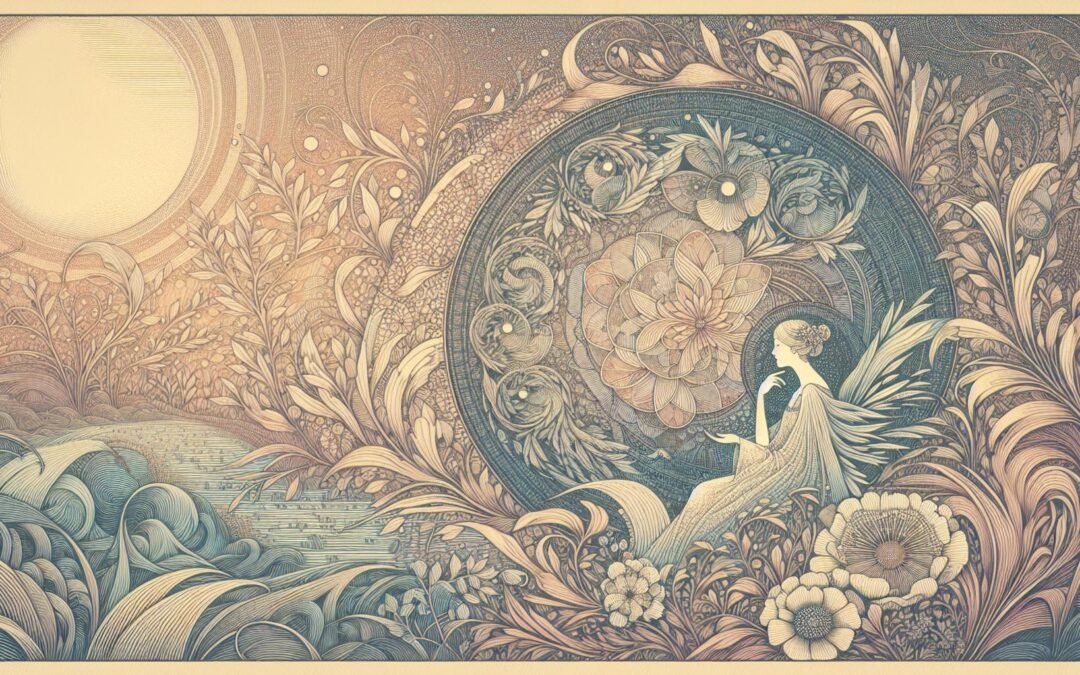Across centuries, love poems for her from the heart persist as the pulse of human expression, each epoch infusing the genre with distinct sound, sense, and urgency. Love poems for her from the heart in any era channel desire through tradition, personal longing, and inherited myth. Real power emerges when a poem turns from the expected—florid declarations and ornamented metaphors—toward an unsparing intimacy and specificity. Literary innovation arrives with a refusal to repeat ancestors, instead, shaping language to bring the beloved’s presence radiantly close or achingly apart.
Love Poems for Her from the Heart: History, Form, and Canon
With Sappho, lyric eros entered written memory through sparse lines charged with devotion and vulnerability. Ancients in Greece, Mesopotamia, and Egypt inscribed yearning onto tablets and papyrus. From Sappho’s fragments arises not just the ache of absence, but also the politics of gaze: the woman becomes both subject and sovereign of her emotion. Courtly poets in medieval Provence reimagined desire through the vocabulary of ritual adoration, shrouding the female addressee in distance, longing, and unattainability—a legacy carried into Petrarchan sonnets, whose stylized melancholy shaped European poetry for centuries. Shakespeare, rupturing idealization, compared hair to “black wires” and confessed honest affection in acts of naming the beloved as mortal and flawed.
Traditions, Transformations, Lineages
The ghazals of Persia transformed separation into art, their refrains circling absent beloveds veiled by conventions of modesty and silence. Li Qingzhao, writing in Song Dynasty China, fused longing with precision, using memory to turn domestic objects into carriers of absent love. European traditions, especially during the courtly and Renaissance periods, magnified the poem as a space of mediation between forbidden devotion and public performance. Poets in the Islamic and Tang worlds drew boundaries between revelation and concealment, encoding longing within metaphoric landscapes and cyclical motifs.
With arrival of the nineteenth century, Romantic poets fractured formality and allowed unmediated feeling to steer voice and line. Sor Juana Inés de la Cruz, Elizabeth Barrett Browning, and later Anna Akhmatova shattered gendered codes, threading female agency into address, motive, and defiance. Browning’s “How do I love thee?” unfolds as iterative adoration, each line stacking love’s measures upon itself with cumulative intensity. Modern figures—Warsan Shire, Ada Limón, Nayyirah Waheed—expand the genre with hybridity, urgency, and performance, giving the beloved not archetype but history, anger, and traceable identity.
Lexicon, Device, and Concrete Address
Richness in ‘love poems for her from the heart’ stems from a willingness to subvert familiar phrases and lexicons. Sappho’s expressions—sometimes pared to a gesture or glance—refused static idealization. In the ghazal, longing branches across time, resting on precise images: the scent of a garden at dusk, the hunger of lips to taste rain. Editors of modern anthologies select verses that prioritize physical contact, tactile verbs, and color-washed nouns. The shift toward the unique arrives in linguistic thews: “opal in the light,” “salt on her wrist,” or “the hush between words.” In Neruda’s songs, fruit and river imagery body forth sensuality while remaining grounded in the tangible.
Rhythm and sound structure drive memory’s return. Poets deploy alliteration, assonance, internal rhyme, and controlled caesurae to anchor emotion in the senses. For instance, “silk skims her skin” conjures both melody and texture. The register ranges broadly: formal invocation (“sovereign of starlit hours”) blurs into private colloquialism (“my wild honey dawn”). Those registers do not merely reflect cultural background but the intended intimacy of the address—whether the beloved exists as muse, confidant, or living witness to the poem’s composition.
Emergence of Female Voice and Agency
Initially, literary traditions embedded the female addressee behind layers of unreachability. However, the last two centuries document a doubling: the poet as beloved and the beloved as poet. Self-address and mutuality surface in the voice of Li Qingzhao, the reclamation of identity by Audre Lorde, and the subversive jokes within contemporary women’s poetry. In these cases, speaking for, about, and to oneself collapses boundaries. The poem then tracks both affection and critique, both celebration and refusal. Retracing these currents proves vital for anyone seeking poems for her with psychological complexity and raw affect.
Social norms have both narrowed and unleashed scope for love poetry. During medieval and Renaissance moments, class and faith shaped how poets circumscribed what could be revealed. Romantic and Modernist eras argued for autonomy, passion, and vulnerability without apology. The contemporary landscape makes agency itself thematic; the beloved no longer stands passively on a pedestal but interrupts, questions, and shapes the poem’s voice, as in the works of Layli Long Soldier and Ada Limón. Forms evolve accordingly: brief lyrics, sprawling free verse, visual poetry.
Canon, Influence, and Selection
‘Love poems for her from the heart’ reach canonical status by synthesizing personal turbulence with linguistic invention. Elizabeth Barrett Browning’s “Sonnet 43” uses enumeration as crescendo, while Sharon Olds grounds the beloved in realities of the body and partnership. War poems of heartbreak and recovery blur genre borders, recasting love not as stasis but transformative act. Canon’s expansion coincides with the reevaluation of sources and citation; no master list captures the living energy of contemporary love poetry, now reshaped by spoken word, online performance, and hybrid forms.
Thematic Nuance and Stylistic Energy
Motifs emerge and dissolve over time—adoration, longing, devotion, idealization, and vulnerability all circulate as points of thematic gravity. These recurring elements inhabit distinct registers in each poetic era, illuminating how personal emotion adapts to sociopolitical pressure, literary fashion, and global catastrophe. For anyone searching for modern American voices, motif and tone converge through clarity, risk, and transformative honesty.
Adoration, Longing, and Idealization
Earlier periods saturated love poems in ritualized praise: hands likened to lilies, skin to alabaster, hair to woven gold. Yet, even canonical adulation often contains irony or shadow—as in Shakespeare’s “Sonnet 130,” where the beloved’s real features break through idealized patterns. Contemporary poets tend toward contradictions. In Limón’s work, adoration bursts forth, then recoils, making space for selfhood and fragility. Each new generation balances the weight of tradition with demands for authenticity.
Longing remains alive wherever desire and fulfillment become uneven partners. Romantic and Victorian modes lingered on yearning as self-abnegation; current voices, however, channel longing toward mutual risk and recognition. Digital poems compress this sense of ache, using short forms and caesurae to evoke the silence between texts. In submissions to short poem collections, absence, imagination, and technology interweave to create new blueprints for connection and regret.
Absence, Agency, and Subversion
Physical and metaphysical absence pervade love lyric, whether oceans or ideals intervene. Ghazals equate absence with poetic origin: the beloved’s withdrawal never marks an ending but a point of return. In classical Chinese and Japanese poetry—see, for instance, tanka and haiku—the fleeting presence of the beloved unites personal feeling with seasonal or fleeting imagery. Good morning poems and farewell verse today adapt these moves, embedding presence inside gestures: a glance, a word saved in a phone, an echo in the morning.
Agency has always been mutable within this genre. Women-centered love poetry emerges from the resistance to roles scripted by gender, faith, and ideology. Sappho’s direct address explodes conventions, and Sor Juana’s sonnets reject the silence imposed upon female intellect and desire. Modern writers—Shire, Waheed, Limón—disallow voicelessness, recasting the beloved as powerful, tender, and active. Poets like Joy Harjo and Tracy K. Smith embed questions about race, ancestry, and survival within texts, refusing static universals.
Realism, Body, and Imagery
Reverence yields to candor in poems by Sharon Olds or Kim Addonizio; tenderness and erotic frankness coexist. Bodily imagery links adoration to the senses, not to abstraction. A hand trembling on the beloved’s cheek conveys more than strings of precious metals or ruined temples. Enumeration, as in Browning’s sonnet, or brief snapshots in poems intended to provoke laughter, show versatility of the form. Metaphors and similes, handled artfully, evoke complexity: “her laughter poured through the door like late rain” creates an ephemeral world unique to the poem’s own laws.
Performance, Culture, and Modernity
Contemporary poems for her live in new media and performance. Instagram poets, spoken word artists, and digital playwrights redirect energy toward the concise, volatile, and suddenly public. Lovers now communicate through text chains, snippets, and memes; the poetic line adapts its cut, punctuation, and white space to these encounters. In translation, motifs of longing, abundance, and memory show migration of genre across borders. Literary Hub documents these transformations in real time, as does Poetry Society UK.
Archival work brings buried voices to light: queer love poems, missives between women, and experimental verse from colonized cultures all revise the center. Internal revolt against cliché remains the poet’s chief act—whether through tactile nouns, unpredictable metaphors, or a refusal to separate selfhood from longing. Epistolary poems, lists, and music-infused stanzas propagate throughout the living tradition.
‘Love poems for her from the heart’ remain unfinished projects of invention, reassembled through fresh rhythms, resonant imagery, and unflinching authenticity. Each period, language, and cultural code leaves a trace, renewed at every utterance.

